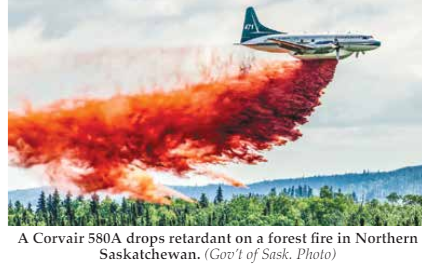
It is going to be another bad fire season in Western Canada. In Alberta, parts of Fort McMurray are evacuating again. In B.C., more than 4,000 residents of Fort Nelson and the Fort Nelson First Nation were ordered to flee this week. Thick smoke has already descended on large swaths of the West, from Edmonton to Winnipeg. As of May 19, there were seven active fires in Saskatchewan. So far, there have been 160 fires, compared with the nine-year average of 92. The fires are grim — and familiar — start to wildfire season in Western Canada as tinder-dry forests go up in flames. In addition to the flames, smoke has descended on Edmonton and other communities, leading to air quality warnings. The smoke from Western Canada wildfires descended around the same time during last year’s devastating fire season, according to Environment and Climate Change Canada. Wildfire smoke made headlines last year, as thick smoke cloaked major cities, including New York City, Toronto and Chicago — a rare phenomenon in eastern urban centres.
Around the world, the size and intensity of wildfires are increasing as climate change impacts deepen. Mike Flannigan, the B.C. Innovation Research Chair in predictive services, Emergency Management and Fire Science at Thompson Rivers University, says climate change is the driving force behind increasing Western Canada wildfires. “Some people won’t like this, but it’s the role of climate change,” he says. “I think B.C. is a really stark example. From 2017 to 2023, we burned more areas than in the previous 58 years. So yeah, we’re going to see more fire in the future and more smoke.” Warmer temperatures mean longer fire seasons and increase the likelihood of lightning — a major fire starter — and sucks more moisture out of the atmosphere, Flannigan says.
Last year shattered records for how much land burned across Canada, and it’s almost impossible to predict exactly what will happen this year, but there are glimmers of hope that it won’t be quite as bad. Fire weather forecasts look positive, according to Flannigan. The notable thing this year, he says, are the fires that smouldered over the winter in both Alberta and B.C. In past years, those would have been dealt with by fire crews in the fall, but those crews were stretched thin late in the season and the hot spots were too vast. “We’re off to a fast start,” he says. “It’s more active than average, but it’s not close to 2023.” According to the BC Wildfire Service, 126 wildfires were burning as of May 16 and conditions in the northeast, where most of the early-season activity is occurring, are creating “aggressive fire behaviour and increased rates of spread, which will challenge suppression efforts.” Sherry Williams, a meteorologist who works on air quality for Environment and Climate Change Canada, said the weekend of May 10 was the first time this year where the air quality in B.C. degraded enough for a special statement from the agency. That’s a little behind last year’s first notice, released on May 5.
Dry conditions in Alberta are stoking flames and fears for a bad wildfire season, with 23 fires still burning from 2023 after a dry winter. As of May 15, there were 45 wildfires in Alberta, according to the province, with fires nearFort McMurray and Grande Prairie burning out of control. All but one of those 45 fires is burning north of Edmonton. The situation for Western Canada wildfires is less dire in Saskatchewan, where seven fires are currently burning, according to the province. Two of those fires were out of control on May 15 and residents of Creighton, near the Manitoba border, were on alert as a fire rages near Flin Flon.
There have been more fires so far this year in Saskatchewan compared to last year, but 30 per cent less area has burned to date, according to the Canadian Interagency Forest Fire Centre. The situation is almost identical in Manitoba, where nine fires are currently burning, with two out of control, according to the province. Both of those fires are near the Saskatchewan border, one near Clearwater Lake and the other east of Flin Flon and eating into Grass River Provincial Park, which forced the evacuation of the community of Cranberry Portage. Statistics from the Canadian Interagency Forest Fire Centre show the number of fires this year are more than double last year’s total at this time, and more than 35,000 hectares had already burned as of May 14 — compared to just over 2,000 hectares last year.
By Drew Anderson and Matt Simmons, Local Journalism Initiative Reporters (The Narwhal)

Leave a Reply